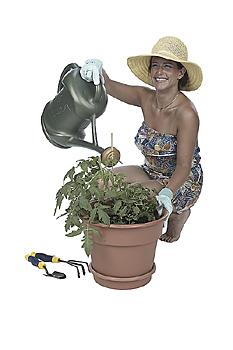 Knee problems are experienced by over 4 million people each year, and are a result of genetics, wear and tear, or injuries. This pain does not have to keep you from enjoying gardening though, incorporating adaptive practices and tools, can keep you working in your garden and caring for your plants!
Knee problems are experienced by over 4 million people each year, and are a result of genetics, wear and tear, or injuries. This pain does not have to keep you from enjoying gardening though, incorporating adaptive practices and tools, can keep you working in your garden and caring for your plants!
Planning
It is always important to consult with a doctor before beginning to adapt your gardening practices so you can discuss any limitations or issues that could further harm your knees. Doctors can recommend exercise programs that can help to strengthen and improve joints. Always make sure to wear good shoes. Never wear old shoes with knee pain, you need shoes that have proper support and promote leg alignment.
It is important to warm up before you begin your gardening, take a short walk to warm up your knees. It is also a good idea to gently stretch the front and back of your thigh as this will alleviate pressure from your knee. Finally create a plan for your time, and remember to move often, not staying a stationary position for long periods of time, as this can hurt your knee. If you feel pain, try performing another task to mix up standing and kneeling.
Plan for your knees
If you have trouble with your needs, plant low maintenance trees or hedges, so you will not have to be on a ladder. Train any vine plants to climb a trellis, so you can harvest plants like beans, cucumbers, and tomatoes without harming your knees. A raised bed can also be beneficial to people with knee issues who want to keep low spreading plants in their gardens.
Add a bench to a raised bed, so you can sit while working, this alleviates much strain from your knees, and keep you gardening! Create paths with packed dirt instead of pavement; the dirt is a better material for your knees then the jarring brick or concrete. Try to avoid paths that may be wet or slippery or have exposed roots, as this can cause balance loss, further injuring knees. Try to incorporate benches or rails into your landscape, this will allow for frequent breaks and railing will help to provide balance as well as take the stress of your knees. Try to level your landscape so you won’t have a downhill grade, or create steps.
Equipment to Help Knee Pain
The incorporation of the following tools will allow gardening to be fun and more comfortable.
- Use knee pads to protect and cushion your joints
- Try to use a walking stick or cane, as this will provide you with balance as you move through plant rows. It will also help you rise to stand.
- Use a long-handled lopper to trim shrubbery so you won’t have to balance on a stool or ladder.
- A pole mounted trimmer will help you spruce up your trees without any climbing
Use these helpful hints to design your own knee-friendly landscape, and don’t give up gardening just because you have a knee injury!
